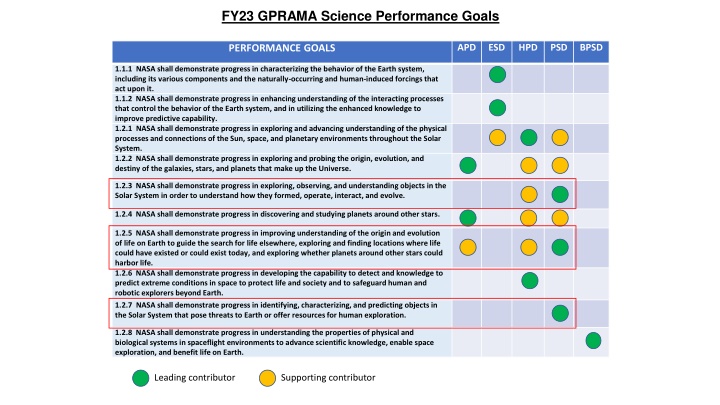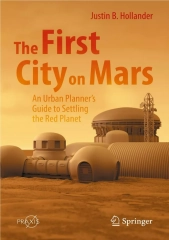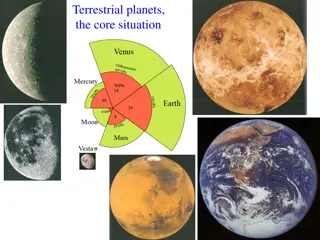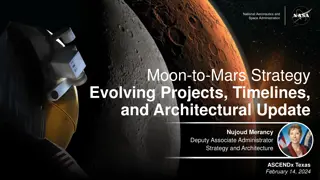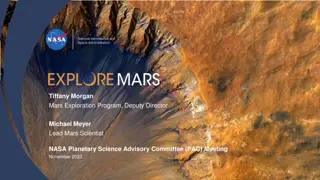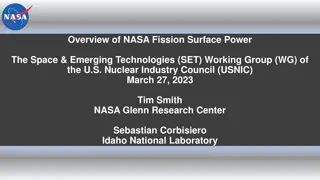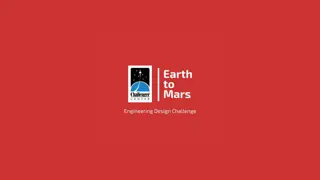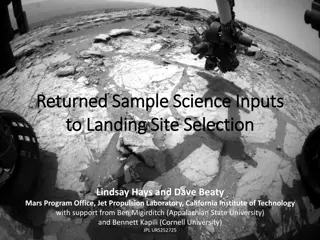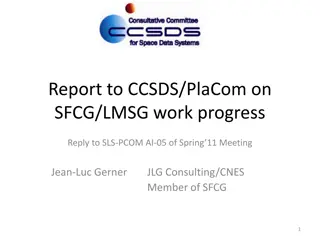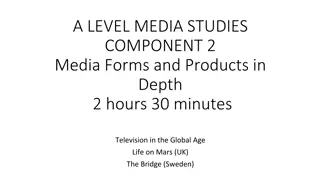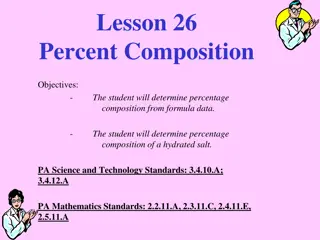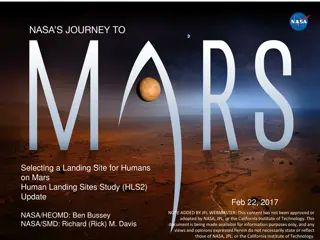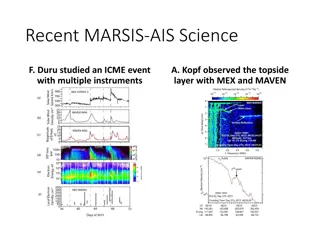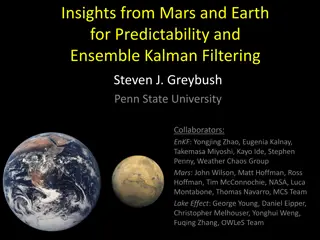Unveiling Mars's Core Composition
Researchers discovered insights into Mars's core composition through seismic wave analysis, suggesting a smaller and denser core with significant light elements like sulfur and oxygen. Understanding planetary core structures is crucial for comparing Earth and Mars formation processes.
Download Presentation

Please find below an Image/Link to download the presentation.
The content on the website is provided AS IS for your information and personal use only. It may not be sold, licensed, or shared on other websites without obtaining consent from the author.If you encounter any issues during the download, it is possible that the publisher has removed the file from their server.
You are allowed to download the files provided on this website for personal or commercial use, subject to the condition that they are used lawfully. All files are the property of their respective owners.
The content on the website is provided AS IS for your information and personal use only. It may not be sold, licensed, or shared on other websites without obtaining consent from the author.
E N D
Presentation Transcript
FY23 GPRAMA Science Performance Goals APD ESD HPD PSD BPSD PERFORMANCE GOALS 1.1.1 NASA shall demonstrate progress in characterizing the behavior of the Earth system, including its various components and the naturally-occurring and human-induced forcings that act upon it. 1.1.2 NASA shall demonstrate progress in enhancing understanding of the interacting processes that control the behavior of the Earth system, and in utilizing the enhanced knowledge to improve predictive capability. 1.2.1 NASA shall demonstrate progress in exploring and advancing understanding of the physical processes and connections of the Sun, space, and planetary environments throughout the Solar System. 1.2.2 NASA shall demonstrate progress in exploring and probing the origin, evolution, and destiny of the galaxies, stars, and planets that make up the Universe. 1.2.3 NASA shall demonstrate progress in exploring, observing, and understanding objects in the Solar System in order to understand how they formed, operate, interact, and evolve. 1.2.4 NASA shall demonstrate progress in discovering and studying planets around other stars. 1.2.5 NASA shall demonstrate progress in improving understanding of the origin and evolution of life on Earth to guide the search for life elsewhere, exploring and finding locations where life could have existed or could exist today, and exploring whether planets around other stars could harbor life. 1.2.6 NASA shall demonstrate progress in developing the capability to detect and knowledge to predict extreme conditions in space to protect life and society and to safeguard human and robotic explorers beyond Earth. 1.2.7 NASA shall demonstrate progress in identifying, characterizing, and predicting objects in the Solar System that pose threats to Earth or offer resources for human exploration. 1.2.8 NASA shall demonstrate progress in understanding the properties of physical and biological systems in spaceflight environments to advance scientific knowledge, enable space exploration, and benefit life on Earth. Leading contributor Supporting contributor
GPRAMA Inputs 2023 PSD
NASA shall demonstrate progress in exploring, observing, and understanding objects in the Solar System in order to understand how they formed, operate, interact, and evolve. PSD 1.2.3
First observation of seismic waves passing through the core of Mars Irving et al.; First observations of core-transiting seismic phases on Mars; Proceedings of the National Academy of Sciences DOI: https://doi.org/10.1073/pnas.2217090120 Researchers set out to answer the question: What is the size and composition of the martian core? The team analyzed seismic signals from two marsquakes on the side of Mars opposite the InSight lander to identify waves that passed through the core. They then compared the travel times of these waves (i.e., the time required to travel from the marsquake epicenter to the seismometer) with those of waves taking different paths through the planet s mantle to determine the seismic wave velocity in the core. These results indicate a somewhat smaller and denser core compared to previous estimates, leaving the researchers to infer that Mars core contains 20 22 wt% of light elements like sulfur, oxygen, carbon, and hydrogen. A precise determination of the light element budget of Mars core is vital in comparing the processes at play during the formation of the Earth and Mars. Such a comparison could reveal the extent to which differences between Earth and Mars are a consequence of the material which accreted to form the two planets, and which are due to the physical conditions (e.g., pressure and temperature) present during planetary differentiation.
Liquid water may be at shallow depths on Europa Chivers et al.; Stable brine layers beneath Europa s chaos; The Planetary Science Journal DOI: https://iopscience.iop.org/article/10.3847/PSJ/acea75 The formation mechanism of Europa's large chaos terrain (> 100 km diameter) and associated lenticulae (< 10 km diameter) has been debated since their observations by the Galileo spacecraft. Their geomorphology and distribution suggest there may be reservoirs of saline liquid water 1 3 km beneath the surface the "shallow water" model generated by injection of ocean water or melting of the ice shell. Recent investigations on the evolution of small shallow- water bodies ( 103km3) suggests that salts with a small effect on melting point (MgSO4) can extend the lifetime of saline bodies by 5% compared to freshwater reservoirs. However, sodium chloride, identified as a potential oceanic salt, has a significantly stronger impact on the freezing point, suggesting a further extension of liquid lifetimes. Moreover, the substantial volumes of liquid water ( 104km3) beneath large chaos could be melted in situ rather than injected through a fracture, implying a distinct chemistry and formation environment. Here, numerical models were used to explore how the chemistry and disparate origins of shallow water control its evolution and lifetime. For small, injected sills, it was found that NaCl can extend their liquid lifetime to 140 kyr up to a 60% increase over freshwater sills. Saline melt lenses will last at least 175 kyr but, in contrast to sills, may persist as a stable layer of brine beneath the surface for over 500 kyr. These results provide further support for the presence of liquid water at shallow depths within Europa's ice shell today. Can note relevance for upcoming NASA mission Potentially good for visuals
Chondritic parent bodies formed later than early-formed planetary embryos and after the primary heat decayed away Mane et al.; Protracted timescales for nebular processing of first-formed solids in the Solar System DOI: https://doi.org/10.3847/1538-4357/acb156 The calcium aluminum-rich inclusions (CAIs) from chondritic meteorites are the first solids formed in the solar system. Rim formation around CAIs marks a time period in early solar system history when CAIs existed as free-floating objects and had not yet been incorporated into their chondritic parent bodies. As seen in the limited number of analyzed inclusions, the rims formed nearly contemporaneously (i.e., <300,000 years after CAI formation) with the host CAIs. This study presents the relative ages of rims around two type B CAIs from NWA 8323 CV3 (oxidized) carbonaceous chondrite using the26Al 26Mg chronometer. Specifically, observations indicate that these rims formed 2 3 million years after their host CAIs, most likely as a result of thermal processing in the solar nebula at that time. This in turn implies that these CAIs remained as free- floating objects in the solar nebula for this duration. The formation of these rims coincides with the time interval during which the majority of chondrules formed, suggesting that some rims may have formed in transient heating events similar to those that produced most chondrules in the solar nebula. Results from this work additionally bolster recent evidence that chondritic materials accreted to form chondrite parent bodies later than the early-formed planetary embryos, and after the primary heat source, most likely26Al, had mostly decayed away. Potentially good for visuals
NASA shall demonstrate progress in improving understanding of the origin and evolution of life on Earth to guide the search for life elsewhere, exploring and finding locations where life could have existed or could exist today, and exploring whether planets around other stars could harbor life. PSD 1.2.5
Using AI to improve life detection strategies on Mars Warren-Rhodes et al.; Orbit-to-ground framework to decode and predict biosignature patterns in terrestrial analogues; Nature Astronomy DOI: https://doi.org/10.1038/s41550-022-01882-x Finding life on Mars is constrained by the technology we are capable of sending to Mars. How scientists can creatively utilize current technology to identify signs of life, and guide future targeted life detection missions is an exciting area of current life detection efforts. A team at the Search for Extraterrestrial Intelligence (SETI) Institute investigated potential biosignatures at Salar de Pajonales, an extremely arid region in the Atacama Desert (northern Chile) analogous to evaporitic environments on Mars. This site was analyzed using predictive models and machine learning on a variety of spatial scales to improve life detection strategies on Mars. With the artificial intelligence-machine learning models, there was an 56.9-87.5% chance of finding life at the site, while a random search had a 9.2% probability over the same area, reducing the physical search space by 85- 97%. These results significantly improve life detection efforts at the scale of microbial habitats, an equivalent scale to current Mars rovers, helping to optimize current and future search efforts on other terrestrial planets. Could note that this was a NASA-funded study by the NASA/SETI team
Limited nitrate on early Earth delays rise of life Kang et al.; Nitrate limitation in early Neoproterozoic oceans delayed the ecological rise of eukaryotes; Science Advances DOI: https://doi.org/10.1126/sciadv.ade9647 The early Neoproterozoic Era witnessed the initial ecological rise of eukaryotes at ca. 800 Ma. To assess whether nitrate availability played an important role in this evolutionary event, this team measured nitrogen isotope compositions ( 15N) of marine carbonates from the early Tonian (ca. 1000 Ma to ca. 800 Ma) Huaibei Group in North China. These data fill a critical gap in the 15N record and indicate nitrate limitation in early Neoproterozoic oceans. Limited nitrate availability in early Neoproterozoic oceans may have delayed the ecological rise of eukaryotes until ~800 Ma when increased nitrate supply, together with other environmental and ecological factors, may have contributed to the transition from prokaryote- dominant to eukaryote-dominant marine ecosystems.
Webb Detects Water Vapor in Rocky Planet-Forming Zone Perotti et al.; Bioverse: Water in the terrestrial planet-forming zone of the PDS 70 disk; Nature DOI: https://doi.org/10.1038/s41586-023-06317-9 Water is essential for life as we know it. However, scientists debate how it reached the Earth and whether the same processes could seed rocky exoplanets orbiting distant stars. New insights may come from the planetary system PDS 70, located 370 light-years away. The star hosts both an inner disk and outer disk of gas and dust, separated by a 5 billion-mile-wide (8 billion kilometer) gap, and within that gap are two known gas-giant planets. New measurements by NASA s James Webb Space Telescope s MIRI (Mid-Infrared Instrument) have detected water vapor in the system s inner disk, at distances of less than 100 million miles (160 million kilometers) from the star the region where rocky, terrestrial planets may be forming. This is the first detection of water in the terrestrial region of a disk already known to host two or more protoplanets. PDS 70 is a K-type star, cooler than our Sun, and is estimated to be 5.4 million years old. This is relatively old in terms of stars with planet-forming disks, which made the discovery of water vapor surprising. Over time, the gas and dust content of planet-forming disks declines. Either the central star s radiation and winds blow out such material, or the dust grows into larger objects that eventually form planets. As previous studies failed to detect water in the central regions of similarly aged disks, astronomers suspected it might not survive the harsh stellar radiation, leading to a dry environment for the formation of any rocky planets. Astronomers haven t yet detected any planets forming within the inner disk of PDS 70. However, they do see the raw materials for building rocky worlds in the form of silicates. The detection of water vapor implies that if rocky planets are forming there, they will have water available to them from the beginning. The discovery raises questions of where the water came from, and how it could survive so close to the star. Further research to answer these questions would provide insight into planet formation. APD contribution to PSD goal 1.2.5
NASA shall demonstrate progress in identifying, characterizing, and predicting objects in the Solar System that pose threats to Earth or offer resources for human exploration. PSD 1.2.7
NASA certified sources of preparation and critical information for planetary defense (1) Status of Near-Earth Object Discovery https://cneos.jpl.nasa.gov/stats/totals.html As of August 15, 2023, asteroid search teams funded by NASA s Near-Earth Object Observations (NEOO) Program found another 2 asteroids larger than one kilometer in size with orbits that can come within Earth s vicinity. Asteroid search teams also found 2,383 smaller asteroids less than one kilometer in size. This brings the total known population of near-Earth asteroids to 32,418, along with 121 Near Earth Comets, as of August 15, 2023. The high-precision orbit predictions computed by the Center for Near-Earth Object Studies at NASA s Jet Propulsion Laboratory (JPL) show that none of these objects is likely to strike the Earth in the next century. However, 2,354 small bodies (of which 152 are larger than one km in size) are in orbits that could become a hazard in the more distant future and warrant continued monitoring. Congress, in the NASA Authorization Act of 2005, directed NASA to find 90 percent of the near-Earth objects down to 140 meters in size. As of August 15, 2023, 10,541 near-Earth asteroids with sizes greater than 140 meters have been discovered and catalogued, 336 in this last year. Models estimate that there are ~25,000 near-Earth asteroids larger than 140 meters in size, which leaves ~58% of the population yet to be discovered after over 25 years of NEO search efforts. (2) NASA Releases Agency Strategy for Planetary Defense to Safeguard Earth from Asteroid and Comet Impacts https://www.nasa.gov/feature/nasa-releases-agency-strategy-for-planetary-defense-to-safeguard-earth Earlier this year, NASA released its Planetary Defense Strategy and Action Plan to guide the agency s efforts to find, track, and better understand asteroids and comets that could pose an impact hazard to Earth. The release of NASA s planetary defense plan coincides and complements the separate national planetary defense plan released by the White House Office of Science and Technology Policy. NASA s Planetary Defense Coordination Office was actively involved in the plan s creation alongside several other federal agencies and offices. Together, the NASA- and national- level plans aim to further humanity s ability to safeguard Earth from asteroid and comet impacts over the next decade. The national plan was presented at this year s 8th IAA Planetary Defense Conference (PDC) in Vienna, Austria in April. The PDC, hosted by the United Nations Office of Outer Space Affairs, brought together scientists, engineers, global thought leaders, policymakers, government officials, and other planetary defense experts to discuss what their respective stakeholders were doing to address the near-Earth object (NEO) impact hazard. Preventing a NEO impact with Earth and avoiding a catastrophic natural disaster poses a complex problem that requires a multidisciplinary approach. Conferences like the PDC provide an invaluable opportunity for experts around the world to come together and share their knowledge, which is essential for maintaining and active and engaged global planetary defense team working to safeguard Earth from NEO impacts.
6/8 DART characterized momentum of small bodies and quantified effect of the first hypervelocity impact experiment (1) Cheng et al.; Orbit-to-ground framework to decode and predict biosignature patterns in terrestrial analogues; Nature Astronomy DOI: https://doi.org/10.1038/s41586-023-05878-z The NASA Double Asteroid Redirection Test (DART) mission performed a kinetic impact on asteroid Dimorphos, the satellite (moon) of the binary asteroid (65803) Didymos on 26 September 2022. DART, a project of the agency s Planetary Defense Coordination Office (PDCO) and the Johns Hopkins Applied Physics Laboratory, was a test of the proposed kinetic impactor technique for deflecting Earth- impacting asteroids (or comets), whereby a spacecraft rams into the asteroid at high speed to change its momentum and, therefore, its orbit. The high-speed impact transfers momentum from the spacecraft to the asteroid and potentially creates a stream of debris from the asteroid that can further change the asteroid's momentum and enhance the deflection. The DART mission was intended to test and demonstrate this asteroid deflection technique, and, in particular, characterize the additional change in asteroid momentum due to any debris coming off the asteroid due to the spacecraft impact. The momentum enhancement factor (due to debris coming off the asteroid) is referred to as "beta. DART, which was about the size of a vending machine, navigated to 7 million miles away from Earth and autonomously collided with its target pyramid-sized asteroid at an approximate speed of 14,000 mph. Following DART s asteroid collision, an international team of astronomers utilized observatories around the world including ones funded by NASA s Near-Earth Object Observations (NEOO) Program to better understand the effects imparted to the asteroid from DART s hypervelocity impact, in tandem with data returned from the Italian Space Agency s LICIACube (Light Italian CubeSat for Imaging of Asteroids) spacecraft. The data indicate that the momentum enhancement factor, beta, was between 2.2 and 4.9, with a nominal value of 3.6. This result shows that the change in asteroid momentum due to debris coming off the asteroid substantially exceeded the momentum of the spacecraft itself and demonstrates that kinetic impact was highly effective in deflecting Dimorphos. DART s success marked humanity s first-ever demonstration of asteroid deflection, and it solidified NASA s standing as the world s premiere space agency and leader in the global field of planetary defense. However, there is still more work to be done since a method like DART could only be used with enough warning time to first identify an asteroid collision hazard prior to mounting a response. As a result, continuing to search for and track NEOs to confirm they aren t an impact hazard to Earth remains a key element of the PDCO.
Demonstrating ability to predict close approaches and impacts (1) NASA System Proactively Predicts Historically Close Approach of Asteroid 2023 BU https://www.jpl.nasa.gov/news/nasa-system-predicts-small-asteroid-to-pass-close-by-earth-this-week On January 26, a small near-Earth asteroid designated 2023 BU made a very close encounter with Earth, passing over the southern tip of South America about 2,200 miles (3,600 kilometers) above the planet s surface and well within the orbit of geosynchronous satellites. In advance of the event, NASA s Scout impact hazard assessment system, maintained by the Center for Near Earth Object Studies (CNEOS) at NASA s Jet Propulsion Laboratory in Southern California, predicted the close approach and proactively notified the planetary defense community of the forthcoming event. Asteroid 2023 BU was discovered on January 21, just five days ahead of its approach to Earth, by amateur astronomer Gennadiy Borisov, also the discoverer of the interstellar comet 2I/Borisov, from his MARGO observatory in Nauchnyi, Crimea. Additional observations were reported to the Minor Planet Center (MPC) the internationally recognized clearinghouse for the position measurements of small celestial bodies and the data was then automatically posted to the MPC s publicly-available Near-Earth Object Confirmation Page. After sufficient observations were collected by astronomers, the MPC announced 2023 BU as an official discovery of a new asteroid. As more positional observations of 2023 BU were submitted to the MPC, astronomers better refined the asteroid s orbit, enabling NASA s Scout to autonomously predict the close approach and notify the planetary defense community of the event. This is significant as this very close approach of 2023 BU to Earth demonstrated that NASA s systems for predicting NEO impacts are properly working and providing benefit to the international planetary defense community. (2) NASA Predicts Small Asteroid 2023 CX1 Impact Over Northwestern France https://cneos.jpl.nasa.gov/news/news209.html A small, approximately 1-meter sized asteroid entered the Earth s atmosphere over northwestern France on February 13 at about 02:59 UTC. The asteroid, designated 2023 CX1, exploded upon impact with Earth s denser atmosphere and produced a bright fireball that was witnessed from regions of England, France, Belgium, Germany, and the Netherlands. NASA s Scout system, maintained by the Center for Near-Earth Object Studies (CNEOS) at NASA s Jet Propulsion Laboratory in Southern California, provided advance notification of the event, marking the seventh asteroid discovery and accurate prediction prior to impact. This information was publicly-shared on the agency s official social media channels along with European Space Agency colleagues, resulting in notable public engagement. Asteroid 2023 CX1 was discovered on February 12 at 20:18 UTC, almost 7 hours prior to impact, by Kriszti n Sarneczky at the GINOP KHK observatory in Hungary. As more observations of the asteroid were reported, NASA s Scout system autonomously calculated the impact probability as 100% certain and notified the planetary defense community. Due to this accurate and advanced impact prediction shared on social media, the 2023 CX1 fireball was widely seen by the members of the public, resulting in numerous photos and videos being shared online. This is significant as the prediction of 2023 CX1 s event demonstrated to the public that NASA is leader in factual and timely reporting of near-Earth object news.
